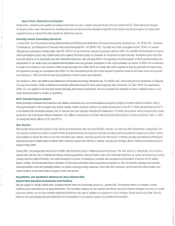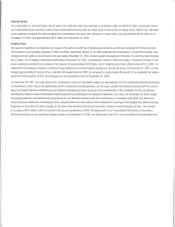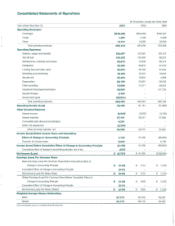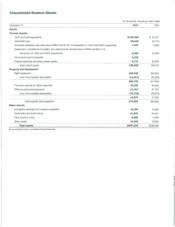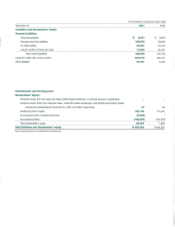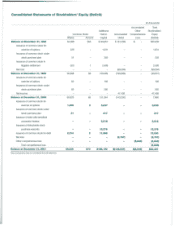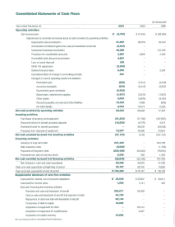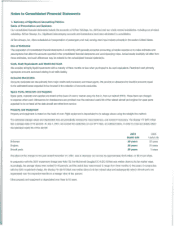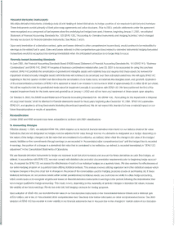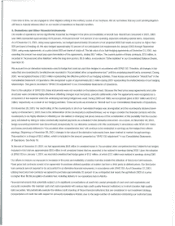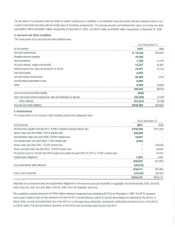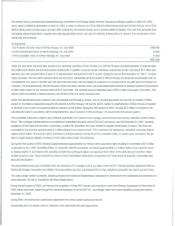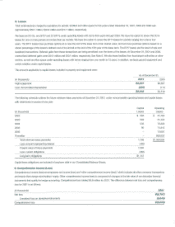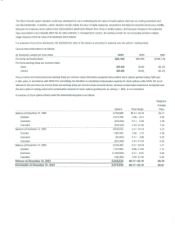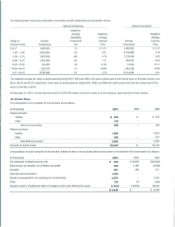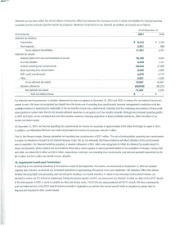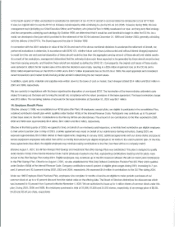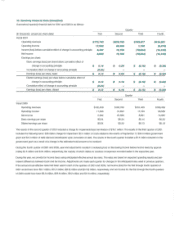Airtran 2001 Annual Report Download - page 29
Download and view the complete annual report
Please find page 29 of the 2001 Airtran annual report below. You can navigate through the pages in the report by either clicking on the pages listed below, or by using the keyword search tool below to find specific information within the annual report.
instruments and some ineffectiveness that has been experienced
in
our
fuel
hedges. See Note 5for further information on our derivatives and
fuel
price
risk management.
3.
Federal Grants and Special Charges Related to Terrorist
Attacks
On September
11,
2001, terrorists hijacked and used four aircraft
in
terrorist attacks on the United States (terrorist attacks). As aresult
of
these
terrorist attacks, the Federal Aviation Administration
(FAA)
immediately suspended all commercial airline flights on the morning
of
September
11.
We resumed flight activity on September
14
and were operating
at
approximately
80
percent of our normal pre-September
11
flight schedule
by September 18, 2001. From September
11
until
we
resumed flight operations on September
14,
we cancelled approximately 1,000 flights.
On September 22, 2001, President Bush signed into law the Air Transportation Safety and System Stabilization Act (the Stabilization Act). The
Stabilization Act provides for
up
to $5 billion
in
cash grants to qualifying U.S. airlines and freight carriers to compensate for direct and incremental
losses, as defined
in
the Stabilization Act, from September
11,
2001 through December
31,
2001, associated with the terrorist attacks. Each airline's
total eligible grant is being determined based on that airline's percentage
of
ASMs during August 2001 to total eligible carriers' ASMs for August 2001.
less an undetermined amount set aside for eligible carriers that provide services not measured by ASMs. The U.S. Department
of
Transportation
(DOl)
will make the final determination
of
the amount
of
eligible direct and incremental losses incurred by each airline. Direct and incremental losses, while
defined generally
in
the Stabilization Act, are subject to interpretation by the
DOT.
Lastly, final applications for grants must be accompanied by Agreed
Upon Procedures reports from independent accountants and may be subject to additional audit or review by the DOT and Congress.
During 2001,
we
recognized approximately $29 million from grants under the Stabilization Act, approximately $24.6 million
of
which we have received
in cash. We expect to receive the remaining amount
in
the second quarter of 2002. We believe our actual direct and incremental losses related to
the September
11
terrorist attacks will exceed the total amount for which we will ultimately be eligible, but the amount
is
subject to change upon final
determination by the DOT
of
our share
of
the total compensation under the Stabilization Act.
We recorded special charges of $2.5 million in 2001 primarily related to operating costs incurred during the period flights were suspended as aresult
of
the terrorist attacks.
4.
Commitments
and Contingencies
At December
31,
2001, our contractual commitments consisted primarily
of
scheduled aircraft acquisitions. As
of
December
31,
2001, our deliveries
of 8717s from the 80eing Company (Boeing) totaled 30 aircraft. Initially, we contracted with Boeing to purchase 50 B717s for delivery between 1999
and 2002, with options to purchase an additional 50 8717s. During 2000, we revised our contracts with Boeing relating to the purchase and financing
of
our future 8717 aircraft deliveries,
in
addition to recharacterizing the 50 option aircraft to provide for 25 options,
20
purchase rights and five rolling
options. The options and purchase rights, to the extent exercised, would provide for delivery to us
of
all
of
our B717s on or before September 30,
2005. Prior to this revision, we had committed to purchase 50 8717s during the following years: 1999 (eight aircraft), 2000 (eight aircraft), 2001
(16 aircraft) and 2002 (18 aircraft). Also prior to the revision, the
50
option aircraft, if exercised, would have been available for delivery between
January 2003 and January 2005.
As
of
December
31,
2001, our remaining commitments with respect to 8717 aircraft were for the acquisition
of
12
aircraft
in
2002 and
11
aircraft
in
2003. Aggregate funding, net
of
previously paid purchase deposits, required for these aircraft commitments was approximately $470.2 million. Although
we expect to finance the acquisition of these aircraft, we did not have financing
in
place for these aircraft at December
31,
2001. See Note
16.
With respect to future 8717 option deliveries, we had
21
options, 20 purchase rights and five rolling options at December
31,
2001. Three
of
the
25 original options were exercised with two 8717s having been delivered
in
2001, and one B717 scheduled for delivery
in
2003; one option expired
un·exercised. See Note 16.
In
November
1997,
we
filed asuit against SabreTech and its parent corporation seeking to hold them responsible for the accident involving Flight 592.
On September 23, 1999, we settled the lawsuit against SabreTech and its parent. The net proceeds
of
$19.6 million from the settlement are included
in
other revenue in our 1999 Consolidated Statement
of
Operations.
Several stockholder class action suits were filed against us and certain
of
our current and former executive officers and directors. The suits were
subsequently consolidated into asingle action. On December
31,
1998,
we
entered into aMemorandum
of
Understanding to settle the consolidated
lawsuit. Although we denied that
we
violated any
of
our obligations under the federal securities laws,
we
paid $2.5 million
in
cash and $2.5 million
in
common stock
in
the settlement which was approved on October 28, 1999.


